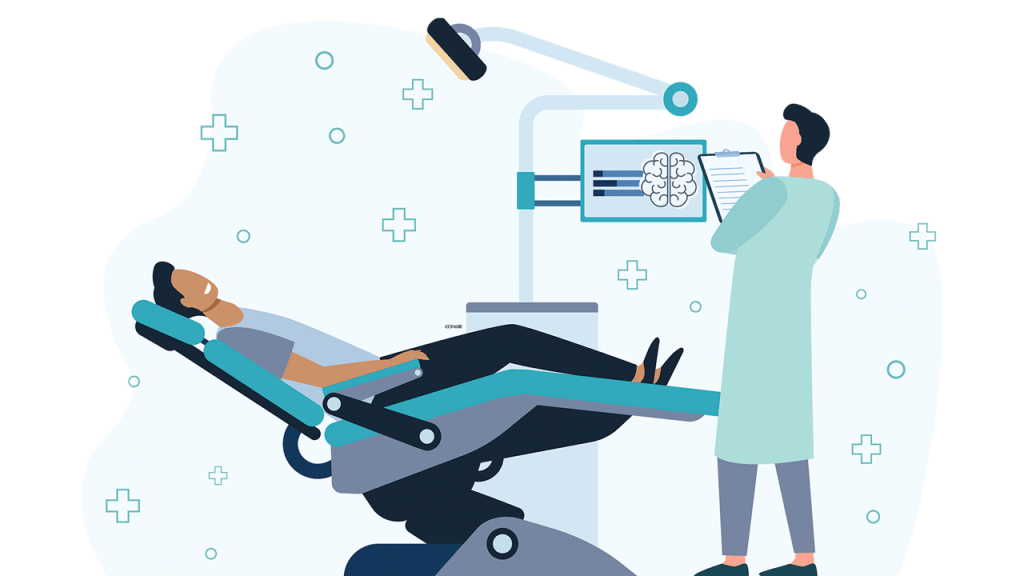TMS For Depression
Transcranial magnetic stimulation is a procedure in which an electromagnetic coil is placed directly over the targeted area. The magnetic field of the device generates small electrical currents that activate specific brain cells with the highest sensitivity to magnetic fields, usually those found in the primary visual and motor regions. TMS for depression treatment has become an increasingly common practice among medical professionals in recent years due to its proven effectiveness. Studies have shown that TMS for depression treatment can help reduce symptoms and increase response rates when used as a complement to traditional methods like medication and psychotherapy.
What is Major Depressive Disorder?
Major depressive disorder (MDD) is a mental health condition that causes a person to suffer from feelings of sadness, anxiety, and hopelessness that persist for longer than two weeks. The National Institute of Mental Health estimates that 1 million American adults, or 8.4% of the population, have MDD in a given year. MDD is often accompanied by feelings of guilt, lethargy, loss of appetite, irritability, poor concentration and extreme suicidal thoughts, and affects both men and women, with no specific age group being more prone to the disorder. MDD is characterized by two diagnosable symptoms: depressed mood and/or loss of interest or pleasure in activities that were once enjoyable, and/or a change in sleeping or eating habits. MDD may be triggered by a traumatic event, genetics, hormonal changes, or certain medical conditions. The most common form of treatment for MDD is medication, although psychotherapy can also be effective.


How Does Transcranial Magnetic Stimulation Work for Depression?
How Quickly Does TMS Work for Depression?
Side Effects of TMS for Depression Treatment
What Are the Benefits of Repetitive Transcranial Magnetic Stimulation for Depression?
Should You Try TMS to treat depression?
If you’re suffering from major depression and other standard treatments haven’t worked for you, TMS may be worth a try. However, it’s important to remember that all depression treatments carry some risk. In the case of TMS, the risks are minimal, but they do exist. If you’ve tried other treatments without any improvement, you may be a good candidate for TMS. You may also be a good candidate if you’re interested in non-invasive and non-pharmaceutical approaches to treating depression. Remember, however, that TMS is not a cure-all. For most people, it won’t take away all the symptoms of depression. Rather, it will simply help to relieve them and make them more manageable. If you’re suffering from depression, you should definitely talk to your doctor about the possibility of undergoing TMS.
What Type of Patient Benefits Most from TMS for Depression?
Although there is no known type of patient that will benefit more from TMS for depression than any other, research suggests that those who have had a prior history of poor response to antidepressant medications may experience more relief with TMS than others. In these cases, repetitive transcranial magnetic stimulation for depression is often used as a treatment option only after other methods have proven ineffective.
Transcranial magnetic stimulation, or TMS, is a non-invasive treatment for depression. Clients receive their therapy over the course of four to six weeks in an outpatient health and wellness space. They wear a helmet that is designed to send repetitive magnetic pulses into the brain; each magnetic coil in the helmet provides magnetic stimulation. Patients who choose this therapy are exposed to short bursts of electromagnetic energy that penetrate the skull and stimulate areas of the brain.
What are the Symptoms of Major Depressive Disorder?
Feeling depressed is more than just feeling sad; it’s a state of being characterized by negative thoughts, feelings, and behaviors that interfere with daily functioning. The American Psychological Association (APA) publishes a list of symptoms associated with major depressive disorder. If you experience these for two weeks or more in any one-year period, you may want to seek help. These include:
- Feelings of emptiness
- Hopelessness
- Loss of interest in activities that used to be pleasurable
- Inability to experience pleasure
- Unusual fatigue
- Insomnia or excessive sleeping
- Inability to focus on tasks
- Constant negative self-talk
- Excessive worry
- Excessive guilt
- Unrealistic beliefs about one’s abilities
- Feelings of worthlessness or shame
- Thoughts of death or suicide
What is Treatment-Resistant Depression?
Treatment-resistant depression (TRD) is diagnosed when a patient does not respond positively to an adequate course of antidepressant medication treatment. In cases of TRD, a patient may have tried two or more antidepressants with no relief in symptoms. In these cases, transcranial magnetic stimulation for depression treatment is often used as a last resort to help patients experience relief from their symptoms.
Long-Term Consequences of Untreated Depression
If you’re depressed and don’t get treatment, not only will you likely continue to feel awful yourself, but you could also have a negative impact on others. Long-term consequences of depression include:
- Increased risk for heart disease
- Decreased cognitive function
- Increased risk for anxiety disorders
- Poor work performance
- Decreased relationship satisfaction
- Increased risk for substance abuse
How Do I Know if I Have Treatment-Resistant Depression?
Treatment-resistant depression is a form of depression that doesn’t respond to antidepressant medications or psychotherapy. This can be a frustrating situation for both the patient and their doctor since depression is a very common condition that can impact people in different ways. Doctors recommend antidepressants to treat depression, but not everyone responds to medications. In these cases, doctors can try different medications or higher dosages, or they may also offer psychotherapy, such as cognitive behavioral therapy (CBT). However, it’s not uncommon for some people with depression to not respond to any treatments or therapies. In these cases, doctors may recommend other treatments, like electroconvulsive therapy (ECT) or transcranial magnetic stimulation (TMS).

Types of Treatment-Resistant Depression
- Mood disorder – People with a mood disorder often have symptoms of both depression and mania at different times. Depressive episodes are usually severe enough to cause a person to miss work or school. They may have trouble sleeping and feel lethargic. They may have low self-esteem and feel hopeless about the future. They may have thoughts of suicide and may attempt suicide.
- Somatic disorder – People with a somatic disorder have symptoms such as pain, fatigue, GI symptoms, and other problems that don’t appear to have a physical cause.
- Psychotic disorder – People with a psychotic disorder may have hallucinations or delusions. They may become paranoid and have difficulty trusting others.
- Personality disorder – People with a personality disorder have persistent patterns of thinking and behaving that cause problems. They may have trouble forming close relationships and problems at work or school. Some types of personality disorders include borderline, paranoid, and narcissistic personality disorder.
TMS therapy is an FDA-approved treatment.
Can Brain Stimulation Help with Treatment-resistant depression?
Brain stimulation is a treatment option that has been studied in people with treatment-resistant depression. Since we don’t really know the exact cause of depression, it can be tricky to treat it. With brain stimulation, you can use these treatment options at the same time, since you’re targeting different areas of the brain. Let’s take a look at the different types of brain stimulation that can be used to treat treatment-resistant depression.
- Electroconvulsive therapy (ECT) – ECT uses electrical stimulation to trigger a seizure. This causes changes in the way the brain works and may reduce symptoms of depression. ECT is a short-term treatment that’s usually given once a week for a few weeks. It’s often used as a last-line therapy for people who don’t respond to other treatments.
- Transcranial magnetic stimulation (TMS) – TMS therapy is a noninvasive treatment that uses magnetic pulses to stimulate specific areas of the brain. It’s often used as a last-line therapy for people who don’t respond to other treatments. A doctor can adjust the strength of the magnetic pulses to find the right level for you.

What Area of the Brain Does Repetitive TMS Target?
Repetitive TMS has been shown to be effective in patients with treatment-resistant depression. Among brain stimulation therapies, repetitive transcranial magnetic stimulation has a unique ability to stimulate nerve cells. It is believed to work by creating chemical changes in the brain. Researchers have found that the areas of the brain that are targeted by TMS are associated with mood regulation. These areas include the left prefrontal cortex and the subgenual cortex. While TMS is not a cure and is rarely recommended as a first-line therapy, it is a promising treatment option for those living with treatment-resistant depression. The magnetic stimulation of transcranial magnetic stimulation disrupts the normal functioning of the neural circuits in the brain that are associated with mood regulation. This disruption is thought to be the cause for the improvement of the symptoms of depression.
Can You Take Medication While Getting Repetitive Transcranial Magnetic Stimulation?
Yes, you can take any current medications for your symptoms while also receiving TMS for depression treatment. Medications can potentially be used in combination with TMS for depression as a way to boost effectiveness. It’s important to discuss your current medications with your doctor to make sure they do not conflict with the TMS procedure.
Is TMS Treatment Painless?
The good news is that TMS treatment is absolutely painless. In fact, many patients report that they don’t even notice the stimulation. You’ll be in the therapy room with the doctor and the machine, but you won’t feel a thing. While some people do report mild discomfort, that’s usually very temporary. Overall, it’s a very low-risk procedure that just might give you that boost you need to get out of the darkness.
Can I Do Talk Therapy While Getting Brain Stimulation Therapies?
Yes! In fact, many psychiatrists and psychologists recommend concurrent therapy, meaning that you’re having both talk therapy and brain stimulation at the same time. While the research is still evolving, many experts believe that combining therapies can bring the best results for patients. The good news is that many psychiatrists and psychologists are well-educated about TMS and other brain stimulation treatments, so you can work with the same person for both types of therapy.
Is Transcranial Magnetic Stimulation the Same as Magnetic Resonance Imaging?
No, they’re definitely not the same thing, although they are both medical procedures that involve electricity. Transcranial Magnetic Stimulation is a medical procedure that sends electricity through your head to the part of your brain that regulates mood. The electricity is delivered by a rapidly changing magnetic field that penetrates your scalp but does not enter your brain tissue.

Does TMS Therapy Help with Other Psychiatric Disorders?
Yes, TMS therapy has been shown to be helpful in treating other mental health disorders, particularly those that are also characterized by low levels of serotonin, such as anxiety, post-traumatic stress disorder, and obsessive-compulsive disorder. However, TMS for depression treatment is the most common and well-investigated use of the procedure. If you are experiencing symptoms associated with any mental health disorder, you should reach out to a doctor as soon as possible. Early diagnosis and treatment can help reduce the intensity of your symptoms and improve your quality of life. While there are many forms of treatment for mental health disorders, not all are equally effective for every patient. If you’ve tried a traditional form of treatment without experiencing relief, you may want to consider taking part in a TMS therapy trial.
TMS was originally used as a treatment for depression. There is now an enormous body of research showing TMS therapy’s efficacy in the treatment of all types of depression. During a TMS session geared toward treating depression, TMS pulses are directed toward the areas of the brain most affected by depressive symptoms. TMS therapy works by altering the neuronal activity and the synaptic connections in the brain – especially in the prefrontal cortex, the area of the brain responsible for high level cognition and decision-making. During a DMS session, magnetic pulses lead to increased activity in this area of the brain. At Lucid, clients with depression receive TMS treatment specifically designed to eliminate symptoms, and the vast majority benefit from complete remission of symptoms.
In recent years, scientists have discovered that TMS therapy can help people who are trying to stay off of drugs and alcohol. One study conducted in 2018 showed that magnetic stimulation leads to a reduction in neuronal firing when a person is confronted with a drug-related trigger or cue. The study demonstrated that people receiving TMS therapy are less likely to relapse on cocaine, alcohol, and other addictive substances.
Recreational drugs are not the only addictions that TMS can help with. Individuals who are trying to quit smoking may get the relief they need simply by going to a few treatment sessions. Recent research shows that people going in for TMS therapy are at a lower risk of relapse, stay off cigarettes longer, and are also more likely to engage successfully in other treatment approaches.
Bipolar disorder is a mental health condition that a person has for life. However, while it is not curable, it is possible to live with bipolar disorder without disruptive symptoms. TMS therapy makes bipolar disorder for more manageable by treating the condition’s symptoms. During bipolar disorder treatment with TMS, magnetic pulses focus on areas of the brain most directly affected by bipolar disorder. As with depression treatment, the magnetic pulses also target the prefrontal cortex of the brain. This level of stimulation increases mood stability and helps clients regulate their thoughts and emotions. As a result, clients with bipolar disorder can live joyful and fulfilling lives.
When it comes to OCD, the most popular treatment options remain behavioral therapies as well as prescription drugs. However, more than two fifths of people with OCD who use this common treatment interventions still experience disruptive symptoms. TMS therapy can be extremely beneficial for these cases. It is also approved by the FDA as a treatment for OCD. When a person with OCD goes in for treatment, the magnetic impulses aim for the areas of the brain that control OCD symptoms.
TMS treatment is one of the safest and most effective approaches to reducing the frequency and intensity of migraines. Migraines are literally caused by dysfunctional brain activity. During TMS treatment, magnetic impulses target the areas of the brain most associated with migraines. These areas include the occipital cortex of the brain. Migraines are partially caused by brain activity that is too high in these areas. The magnetic pulses that occur during TMS treatment reduce this overactivity. After even a single session, many clients report a dramatic drop in migraine frequency – and the vast majority find that the symptoms and pain levels are far more manageable.
Peripartum depression is an extremely common condition that many people find too taboo to discuss, despite how common it is. It is a type of depression that occurs while a person is pregnant. However, it can also be diagnosed during the first year after childbirth. Many new mothers, pregnant mothers, or nursing mothers are reluctant to take prescription drugs that may affect their child. TMS therapy is FDA-approved, non-invasive, and extremely safe. As an intervention for perinatal depression, it stands above other options. Transcranial magnetic stimulation at Lucid in Los Angeles, CA can help mothers at any stage get relief from their depressive symptoms, allowing them to focus on their lives and their families.
Borderline personality disorder is a condition that is often very difficult to treat. Left untreated, however, it can make it very difficult for a person to sustain relationships or live healthy and fulfilling lives. One study in 2017 showed that TMS can help people with borderline personality disorder by decreasing their rate of self-harm and suicidal ideation. As a side effect, patients with borderline personality disorder who received TMS therapy also found that their behavior in social situations improved. The stronger interpersonal relationships and improved social functioning immediately led to a better quality of life for these patients.
Alzheimer’s Disease can be one of the most painful conditions – for the person diagnosed with it as much as their family members. At Lucid’s treatment center in Los Angeles, California, we use TMS therapy to help individuals who are at any stage of this debilitating brain condition. TMS treatment for Alzheimer’s can help patients get relief from symptoms. Studies show that it may significantly reduce the symptoms of mild Alzheimer’s and even slow down the progression of the disease.
Memory loss, which is distinct from dementia and Alzheimer’s Disease, is often simply part of getting older. That doesn’t mean that it’s inevitable, though, or that it can’t be treated. While memory loss to some degree will happen no matter what as a person gets older, TMS can be used to dramatically reduce the rate of memory loss. It can also prevent this condition from getting more severe. Lucid is one of Los Angeles’ top treatment centers for TMS therapy for memory loss.
TMS therapy can be helpful for individuals who do not have debilitating conditions as well. The many benefits of this therapeutic modality can help individuals achieve peak performance in any number of areas, including cognitive performance, mood, and concentration. Why reach for coffee when you can improve how your brain functions on the neurological level? TMS peak performance treatment at Lucid is most helpful, for individuals who have mild anxiety, mild depression, or those who are reluctant to take prescription drugs – or who have found prescription drugs ineffective.
Schedule your free consultation today.
Treatments are fast and can be done on your lunch break with same day and next day appointments available to fit your busy schedule.
Click here to fill out the new client form and we will call you to schedule an initial consultation or next appointment for TMS therapy at our Los Angeles clinic. You can also reach us sooner by calling (323) 792-2071.


